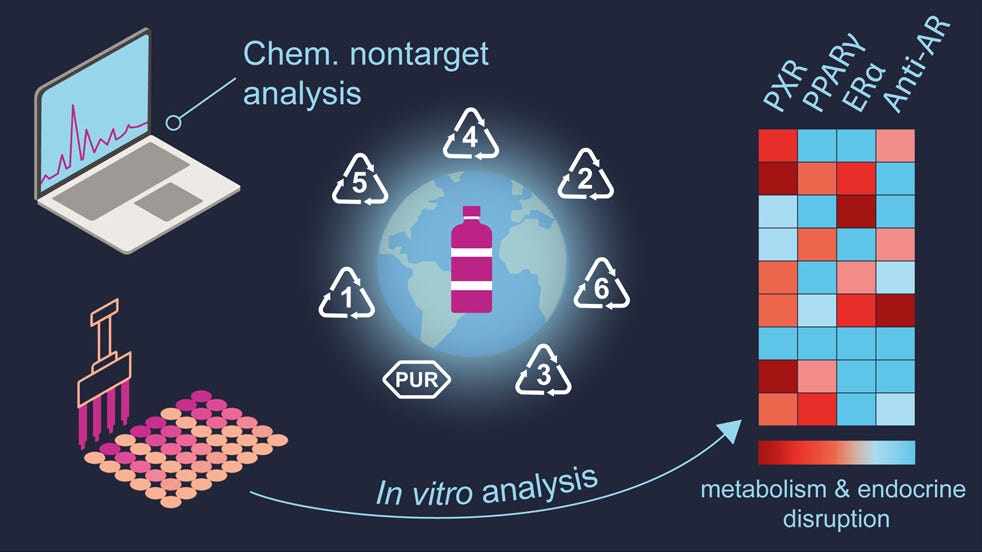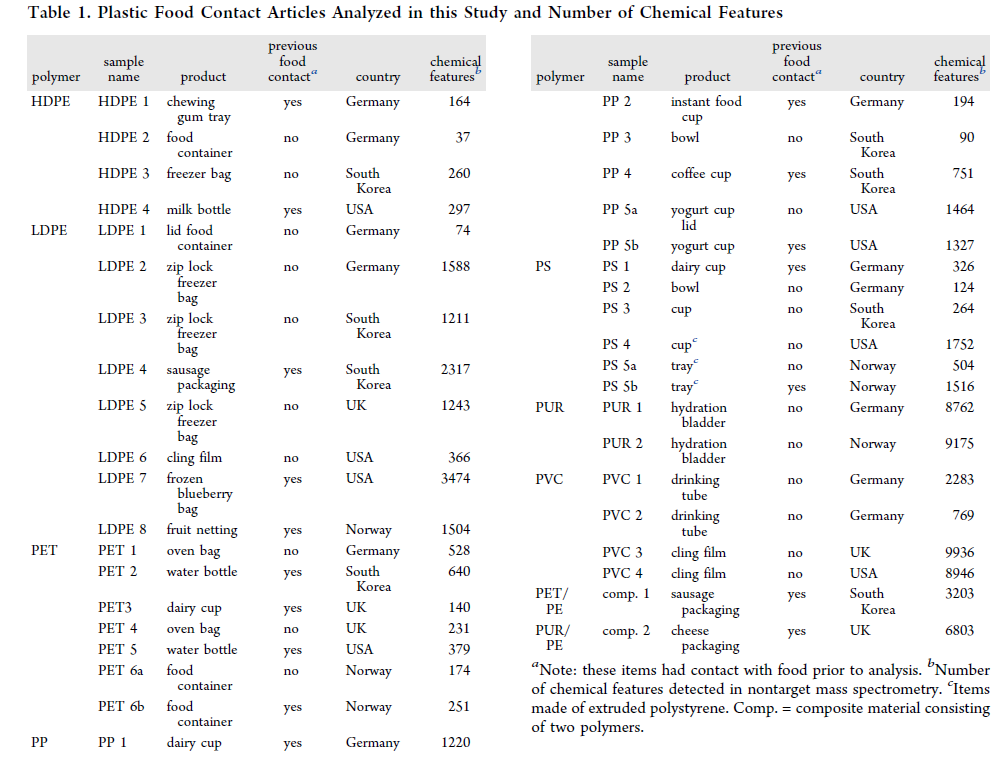Plastic Food Packaging from Five Countries Contains Endocrine- and Metabolism-Disrupting Chemicals
This recent article on food packaging had some very important news. We know that plastic polymer can produce highly toxic effects in the human body.
by Ana Maria Mihalcea, Md, Phd
This recent article on food packaging had some very important news. We know that plastic polymer can produce highly toxic effects in the human body. I have extensively written about this in relation to the self assembly nanotechnology polymers. The reason this paper is so important is this: while there were only a few polymers identified, that one polymer had SEVERAL THOUSAND individual chemicals in them. Imagine what that means for humans and the health of our biosphere with microplastics being ubiquitous - any nobody knows what kind of disease processes exactly these chemicals are causing in the human body. The chemicals from the packaging also go into the food. The scientists tested specifically for endocrine disruption, which we know that phthalates, which are chemical derivatives of plastics, can cause.
Plastics are complex chemical mixtures of polymers and various intentionally and non intentionally added substances. Despite the well-established links between certain plastic chemicals (bisphenols and phthalates) and adverse health effects, the composition and toxicity of real-world mixtures of plastic chemicals are not well understood. To assess both, we analyzed the chemicals from 36 plastic food contact articles from five countries using nontarget high-resolution mass spectrometry and reporter-gene assays for four nuclear receptors that represent key components of the endocrine and metabolic system. We found that chemicals activating the pregnane X receptor (PXR), peroxisome proliferator receptor γ (PPARγ), estrogen receptor α (ERα), and inhibiting the androgen receptor (AR) are prevalent in plastic packaging. We detected up to 9936 chemical features in a single product and found that each product had a rather unique chemical fingerprint. To tackle this chemical complexity, we used stepwise partial least-squares regressions and prioritized and tentatively identified the chemical features associated with receptor activity. Our findings demonstrate that most plastic food packaging contains endocrine- and metabolism-disrupting chemicals. Since samples with fewer chemical features induce less toxicity, chemical simplification is key to producing safer plastic packaging.
This next paragraph explains why contact with these plastics is so harmful, it is because the chemicals RELEASE from the polymer and thus leach into the food they encase. This happens with all plastics we use as containers.
Indeed, plastics are considered a main source of chemical exposure to humans and the environment.5 This is because most plastic chemicals are not chemically bound to the polymer matrix, resulting in their release from plastic via migration or volatilization. Within that broader context, plastic food contact articles (FCAs), that is, plastic used to package or process food, are particularly relevant for human exposure.6 For instance, certain plastic chemicals, such as bisphenol A (BPA) and phthalates, have been detected in more than 90% of the US population.
In the following paragraph it is explained that endocrine dyruption is only one of the problems these chemicals cause - they cause metabolic diruption as well as energy production impairment. Hence you could say they cause accelerated aging and all diseases of aging, including cancer. The other problem to consider is bioaccumulaton and synergy. For example with heavy metals, that I specialize in chelating out of people, many toxic metals synergistically collaborate to enhance their singular toxicity. Much of those have never been studies in their cumulative toxicity. This is the same here as well. Please read:
Plastic chemicals have adverse health effects across the full life cycle of plastics. (10) Here, endocrine-disrupting chemicals, compounds “that interferes with any aspect of hormone action”, (11) are of particular concern. A chemical disruption of the endocrine system contributes to a wide range of adverse health effects, including reproductive, developmental and metabolic disorders, and cancer. (12) There is robust evidence that links exposures to BPA and phthalates to such adverse outcomes (13) resulting in substantial societal costs. (14,15) Moreover, emerging evidence suggests that metabolism-disrupting chemicals (MDCs) represent another relevant class of compounds. (16,17) MDCs promote obesity, type 2 diabetes, or other metabolic disorders, thereby contributing to the increase in noncommunicable diseases. (16,18,19) Metabolic disruptions can be mediated via nuclear receptors, such as peroxisome proliferator-activated receptor γ (PPARγ) which is pivotal in lipid metabolism and adipogenesis. (20,21) Additionally, pregnane X receptor (PXR), besides its role as xenobiotic sensor, is involved in regulating energy homeostasis, including glucose and lipid and bile acid metabolism. (22−24) Its ability to bind diverse chemicals also renders PXR an interesting target to screen for baseline toxicity. Notably, BPA and phthalates also function as MDCs. (18,25) Accordingly, plastic products, including FCAs, can be a source of exposure to endocrine disrupting chemicals (EDCs) and MDCs.
Using high-resolution mass spectrometry, we detected 16,846 unique chemical features in seven PUR and PVC samples and 8665 features in the 29 PE, PET, PP, and PS samples. The number of features differed markedly between FCAs with a minimum of 37 features in a food container (HDPE 2) to a maximum of 9936 features present in a cling film
You can see here what the abreviations mean:
We purchased 36 plastic FCAs covering the seven polymer types with the highest global market share, 34 including high- and low-density polyethylene (HDPE, LDPE), poly(ethylene terephthalate) (PET), polypropylene (PP), polystyrene (PS), polyurethane (PUR), and poly(vinyl chloride) (PVC) from domestic retailers in five countries (USA, U.K., South Korea, Germany, and Norway)
This is a list of the shocking amounts of chemicals found:
Polymers Differ in Number of Chemical Features.
The number of features differs across the polymer types with a gradient ranging from HDPE (616 features), PET (1320), PS (2284), PP (2711), LDPE (5495), and PVC (12,683) to PUR (13,004, Table S6). We observed a similar pattern with regard to the features’ abundance in the mass spectrometry: the median abundances in HDPE (26) and PET (43) were significantly lower than in PUR and PVC (439 and 508). This indicates that the latter polymers do not only contain more chemicals but also higher levels of those. This is due to the fact that PVC and PUR require more additives in their production compared to other polymers
Tentatively Identified Compounds. In total, we tentatively identified 4137 chemicals (17% of all features, identification level 3).37 However, this corresponds to 2146 unique identifications only, indicating that multiple features were identified as the same compound (Table S7). In the PE, PET, PP, and PS samples, 1760 chemicals (20%) were identified, comprising 1182 unique chemicals. Among the FCAs made of PVC and PUR, 2377 features (14%) were tentatively identified corresponding to 1371 unique chemicals (Tables S7 and S14, more details in S2.3). Of the ten most abundant features per sample, we tentatively identified 69 chemicals and retrieved use and toxicity information from PubChem. Our analysis shows that 43 of these chemicals are probably used in plastics as colorants, plasticizers, flame retardants, antioxidants, and processing aids.
Summary:
The amount of chemicals released from polymer plastic food packaging is almost incomprehensible. We are bombarded and under assault with chemicals of unknown toxicity in their singular elements. What is even more important to understand is that each of these polymers - polyvinyl chloride, polyurethane, high and low density polyethylene, polystyrene have been found in human blood. All of these are also listed as stealth nanoparticles in the C19 bioweapon Moderna patent. Polymers are being aerosolized via geoengineering programs. This study explains that each polymer leaches thousands of toxic chemicals into our bodies.
How much of our societies disease burden is related to these plastic polymers now found in food, water, and our air via geoengineering operations that are causing a planetary extinction level event for plant and animal species at beyond alarming rates. It has not yet occurred to most people that if our trees, plants, animals are going extinct, our oceans, soils and air are poisoned, we humans as a species - are next in line, destined for total destruction. We are a part of all life, and need the web of life to survive. When we destroy the web of life, we destroy ourselves.
Go paid at the $5 a month level, and we will send you both the PDF and e-Pub versions of “Government” - The Biggest Scam in History… Exposed! and a coupon code for 10% off anything in the Government-Scam.com/Store.
Go paid at the $50 a year level, and we will send you a free paperback edition of Etienne’s book “Government” - The Biggest Scam in History… Exposed! OR a 64GB Liberator flash drive if you live in the US. If you are international, we will give you a $10 credit towards shipping if you agree to pay the remainder.
Support us at the $250 Founding Member Level and get a signed high-resolution hardcover of “Government” + Liberator flash drive + Larken Rose’s The Most Dangerous Superstition + Art of Liberty Foundation Stickers delivered anywhere in the world. Our only option for signed copies besides catching Etienne @ an event.







